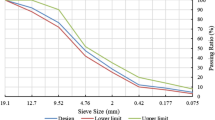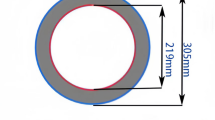Abstract
The accumulation of damage due to repeated loading is considered as the primary reason for the fatigue cracking of bituminous pavements. Due to the intermittent nature of loading in the field, the bituminous mixtures tend to heal during the rest period resulting in increased fatigue life. The healing of the bituminous mixtures is predominantly governed by the binder component, and hence quantifying the healing potential of the binder is indicative of the healing potential of the mix. Currently, the increased use of recycled asphalt pavements (RAP) in new construction, as well as rehabilitation has triggered the use of rejuvenators for restoring the RAP binder properties. As such, the rheological and physico-chemical evaluation of blender RAP binders (with rejuvenators) is critical. In the present study, four different rejuvenators are used for rejuvenating the RAP binder, which include two types of Paraffinic oils, Tall oils and Fatty acids. The healing potential of the RAP binder blended with different rejuvenators is investigated with the help of Linear Amplitude Sweep (LAS) tests carried out in two ways. The first method is a continuous LAS test without any rest period and the second method incorporates rest periods of various duration at different damage levels. The advantages of incorporating rest periods in a LAS test have been quantified in terms of improved binder healing potential. In addition, the physico-chemical properties of the blended RAP binders were assessed through SARA analysis. An attempt has been made to explain the fatigue performance and healing potential of blended RAP binders in LAS tests by virtue of their chemical composition obtained from physico-chemical analysis (SARA analysis). Also, the effectiveness of various rejuvenators in improving the healing potential of RAP binders has been evaluated.







Similar content being viewed by others
References
Pronk A C 1997 Healing during Fatigue in 4 Point Dynamic Bending Tests. Report: W-DWW-97-095, DWW, Delft, The Netherlands
Wang C, Xie W and Underwood B S 2018 Fatigue and healing performance assessment of asphalt binder from rheological and chemical characteristics. Materials and Structures/Materiaux et Constructions 51(6): 1–12
Wang C, Chen Y and Cao W 2019 A chemo-rheological approach to the healing characteristics of asphalt binders under short- and long-term oxidative aging. Construction and Building Materials 221: 553–561
Ramya Sri M, Satya Lakshmi A N and Reddy K S 2020 Fatigue and Healing Characteristics of RAP Mixtures. Journal of Materials in Civil Engineering 32(12): 04020390
Little D N, Lytton R L, Williams D and Chen C W 2001 Healing in Asphalt and Asphalt Concrete, Volume I: Microdamage and Microdamage Healing. Report No. FHWA-RD-98-141, Texas Transportation Institute, College Station, Texas
Lesueur D 2009 The colloidal structure of bitumen: Consequences on the rheology and on the mechanisms of bitumen modification. Advances in Colloid and Interface Science 145: 42–82
NCAT 2014 NCAT Researchers Explore Multiple Uses of Rejuvenators. Asphalt Technology News 26: 1–16
Apostolidis P, Liu X, Kasbergen C and Scarpas A T 2017 Synthesis of asphalt binder aging and the state of the art of antiaging technologies. Transportation Research Record 2633: 147–153
Tran N H, Taylor A and Willis R 2012 Effect of rejuvenator on performance properties of WMA mixtures with high RAP and RAS contents. NCAT Report 12-05, Auburn, AL
Mazzoni G, Bocci E and Canestrari F 2018 Influence of rejuvenators on bitumen ageing in hot recycled asphalt mixtures. Journal of Traffic and Transportation Engineering (English Edition) 5: 157–168
Espinoza-Luque A F, Al-Qadi I L and Ozer H 2018 Optimizing rejuvenator content in asphalt concrete to enhance its durability. Construction and Building Materials 179: 642–648
Forton A, Mangiafico S, Sauzéat C, Di Benedetto H and Marc P 2020 Properties of blends of fresh and RAP binders with rejuvenator: Experimental and estimated results. Construction and Building Materials 236: 117555
Guduru G, Kumara C, Bharath G and Kuna K K 2021 Effectiveness of Different Categories of Rejuvenators in Recycled Asphalt Mixtures. Journal of Transportation Engineering, Part B: Pavements 147: 04021006
Kumara C, Guduru G, Bharath G and Kuna K K 2022 Study on Aging Resistance of Bitumen Rejuvenated with Various Rejuvenators for Hot Recycling. In: Di Benedetto H., Baaj H., Chailleux E., Tebaldi G., Sauzéat C., Mangiafico S. (eds), Proceedings of the RILEM International Symposium on Bituminous Materials, RILEM Bookseries,Springer, Cham, 27
Kim Y R and Little D N 1990 One-dimensional constitutive modeling of asphalt concrete, Journal of Engineering Mechanics 116:751–772
Park S W, Kim Y R and Schapery R A 1996 A viscoelastic continuum damage model and its application to uniaxial behavior of asphalt concrete. Mechanics of Materials 24: 241–255
Schapery R A 1975 A theory of crack initiation and growth in viscoelastic media, III- Analysis of continuous growth. International Journal of Fracture 2: 549–562
Roque R, Birgisson B, Drakos C and Dietrich B 2004 Development and field evaluation of energy-based criteria for top-down cracking performance of hot mix asphalt. J. Assn. Asphalt Paving Technologists 73: 229–260
Johnson C M 2010 Estimating Asphalt Binder Fatigue Resistance Using an Accelerated Test Method. Ph.D. Dissertation, University of Wisconsin- Madison, Madison, WI
Hintz C, Velasquez R, Johnson C and Bahia H 2011 Modification and validation of linear amplitude sweep test for binder fatigue specification. Transportation Research Record 2207: 99–106
Hintz C and Bahia H 2013 Simplification of linear amplitude sweep test and specification parameter. Transportation Research Record 2370: 10–16
Xie W, Castorena C, Wang C and Kim Y R 2017 A framework to characterize the healing potential of asphalt binder using the linear amplitude sweep test. Construction and Building Materials 154: 771–779
Sabouri M, Mirzaeian D and Moniri A 2018 Effectiveness of Linear Amplitude Sweep (LAS) asphalt binder test in predicting asphalt mixtures fatigue performance. Construction and Building Materials 171: 281–290
Cao W and Wang C 2018 A new comprehensive analysis framework for fatigue characterization of asphalt binder using the Linear Amplitude Sweep test. Construction and Building Materials 171: 1–12
Cao W and Wang C 2019 Fatigue performance characterization and prediction of asphalt binders using the linear amplitude sweep based viscoelastic continuum damage approach. International Journal of Fatigue 119: 112–125
ASTM D4124 2009 Standard Test Method for Separation of Asphalt into Four Fractions. ASTM International, West Conshohocken, Pennsylvania, USA
Santagata E, Baglieri O, Dalmazzo D and Tsantilis L 2009 Rheological and Chemical Investigation on the Damage and Healing Properties of Bituminous Binders. Asphalt Paving Technology: Proceedings of the Technical Sessions, Association of Asphalt Paving Technologists 78: 567–595
Yang C, Xie J, Wu S, Amirkhanian S, Zhou X, Ye Q, Yang D and Hu R 2020 Investigation of physicochemical and rheological properties of SARA components separated from bitumen. Construction and Building Materials 235: 117437
IS: 73-13 2013 Specification for Paving Bitumen. Bureau of Indian Standards, New Delhi, 2013
EAPA 2018 Recommendations for the use of rejuvenators in hot and warm asphalt production. Belgium
Matolia S, Guduru G, Gottumukkala B and Kuna K K 2020 An investigation into the influence of aging and rejuvenation on surface free energy components and chemical composition of bitumen. Construction and Building Materials 245: 118378
ASTM D2872 2022 Standard Test Method for Effect of Heat and Air on a Moving Film of Asphalt (Rolling Rolling Thin-Film Oven Test). ASTM International, West Conshohocken, Pennsylvania, USA
ASTM D6521 2022 Standard Practice for Accelerated Aging of Asphalt Binder Using a Pressurized Aging Vessel (PAV). ASTM International, West Conshohocken, Pennsylvania, USA
AASHTO TP 101-14 2014 Estimating Damage Tolerance of Asphalt Binders Using the Linear Amplitude Sweep. American Association of State Highway and Transportation Officials, Washington D.C., USA
National Academies of Sciences, Engineering, and Medicine 2020 Evaluating the Effects of Recycling Agents on Asphalt Mixtures with High RAS and RAP Binder Ratios. Washington, DC: The National Academies Press. https://doi.org/10.17226/25749
Author information
Authors and Affiliations
Corresponding author
Rights and permissions
About this article
Cite this article
Gupta, A., Sasidharan, D., Gottumukkala, B. et al. Evaluation of healing performance of blended reclaimed asphalt binders with rejuvenators based on rheological and chemical properties. Sādhanā 48, 139 (2023). https://doi.org/10.1007/s12046-023-02213-0
Received:
Revised:
Accepted:
Published:
DOI: https://doi.org/10.1007/s12046-023-02213-0




